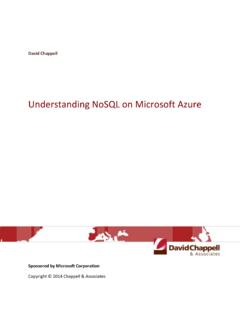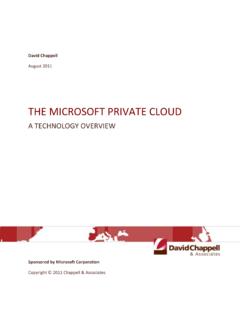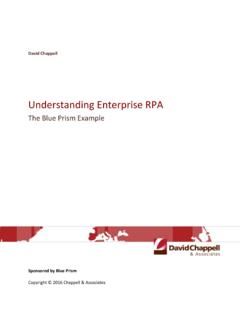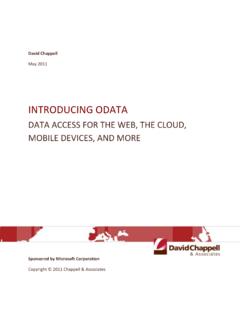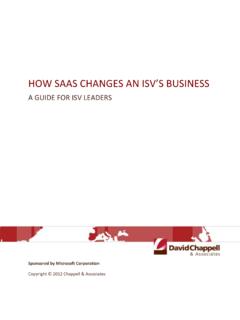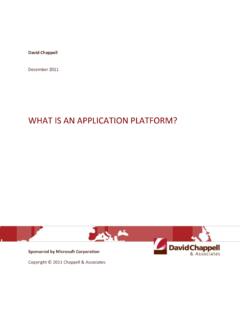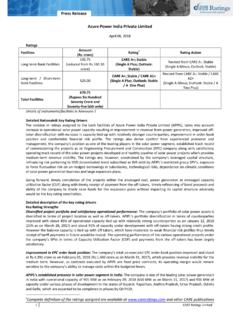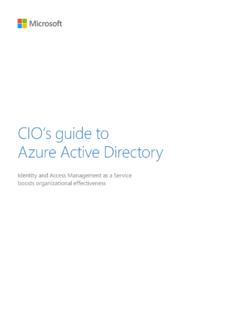Transcription of ADOPTING MICROSOFT AZURE - David Chappell
1 David Chappell ADOPTING MICROSOFT AZURE A GUIDE FOR IT LEADERS Sponsored by MICROSOFT Corporation Copyright 2014 Chappell & Associates 2 Contents Public Cloud Platforms: The Future of Enterprise Computing .. 3 Addressing Cloud Concerns .. 3 Security ..3 Compliance ..4 Infrastructure Scenarios .. 5 Using Cloud Storage ..5 Building a Dev/Test Environment ..6 Providing Single Sign-On to SaaS Supporting Disaster Recovery ..8 Deploying Packaged Applications ..9 Moving Existing Applications ..10 New Application Scenarios .. 12 Creating Employee-Facing Applications.
2 12 Creating Customer-Facing Applications ..13 Creating Parallel Applications ..15 Final 16 About the Author .. 17 3 Public Cloud Platforms: The Future of Enterprise Computing There s no denying it: enterprise computing is moving to public cloud platforms. The benefits the cloud brings, including greater flexibility and lower costs, are becoming too obvious to resist. Starting now, every IT leader needs to think seriously about how they ll use cloud platforms. But this is a big change. Relying on a cloud platform, such as MICROSOFT AZURE , is different from what you re doing today.
3 Making this transition will take time and thought. And the best place for you to begin isn t necessarily obvious. While you ll probably run mission-critical applications on a public cloud platform at some point, starting here isn t a realistic option for most organizations it feels too risky. Yet there are other scenarios that can provide value immediately with manageable risk. You can start small, then expand when you re ready. This overview describes how organizations can adopt MICROSOFT AZURE . We ll look at the most common scenarios, starting with the simplest, and show the business value of each one.
4 The goal is to help you think about which cloud scenarios might make sense for your organization today. It s useful to group these scenarios into two broad categories: Infrastructure scenarios that improve the operational aspects of running an IT organization. The usual goal here is to provide the most reliable service at the lowest cost. New application scenarios that create custom software used by your employees or your customers. The overarching goal here is to create competitive advantage for your organization. You do this by developing and deploying new applications faster, exploiting technology innovation to differentiate your firm from your competitors, and in other ways.
5 As we ll see, a cloud platform can have value in both categories. Addressing Cloud Concerns MICROSOFT AZURE provides computing services from datacenters in North America, South America, Europe, Asia, and Australia. These datacenters are large and highly automated, which is why they can offer scalable services and low prices. But running your applications and storing your data in remote datacenters owned by somebody else can feel scary. This approach to computing also raises legitimate concerns about compliance with whatever laws and regulations your organization is subject to.
6 Before walking through how you can use a cloud platform, it s important to look more closely at both of these issues. Security For just about everybody, the first concern that comes to mind with public cloud platforms is security. You wonder how you can rely on AZURE or another cloud platform to handle this for you. You might start by thinking honestly about whether your datacenter is more secure than an AZURE datacenter. MICROSOFT very likely has more resources than you do to build and operate state-of-the-art security technologies, to 4 carefully vet the people who work in its datacenters, and more.
7 If you think your datacenter is more secure than an AZURE datacenter, you re probably mistaken. Yet the real issue with using a public cloud platform isn t security it s trust. If you re responsible for a datacenter today, you probably lie awake some nights worrying. Are your firewall settings correct? Are your administrators honest? You worry about these things because they re your responsibility, and so it s your job to get them right. With a cloud platform, these issues are no longer yours to worry about. In fact, you have no control over them. If you tour an AZURE datacenter, MICROSOFT will happily let you look at their servers and other hardware from a distance, but they won t let you examine the details.
8 You can t check the firewall settings, for example, or look through the resumes of the datacenter administrators. Instead, you have to trust MICROSOFT to get this right. The reality is that using a cloud platform requires you to trust the platform s provider. How do you build trust? Most often, you do it slowly. You start small, see the benefits, and then take the next step. This is exactly how organizations typically adopt AZURE . If you re like most of your peers, this stepwise approach to the cloud is the route you ll take. And ask yourself this: How much does using AZURE require you to increase the trust you already have in MICROSOFT ?
9 After all, you regularly let MICROSOFT install whatever software the company chooses directly into your operating system via Windows Update. You probably don t worry about whether the next update will contain code that steals all of your data; you just trust MICROSOFT not to do this. Over time, Windows Update has provided real benefits, and you ve learned not to worry about it. Expect to walk a similar path with AZURE . The truth is that the level of trust you already have in MICROSOFT through Windows Update and more is probably at least as great as what AZURE asks of you.
10 Compliance Once you ve decided to trust a public cloud platform enough to get started, the next question that arises is often compliance. How can you be sure that it s legal for your organization to do this? Answering this question can be challenging. Different industries have different requirements financial services firms are typically more constrained than manufacturing companies, for example and the rules also differ across countries. Add to this the fact that many of these laws and regulations were written before cloud computing existed, and the result is a complex stew of rules.
